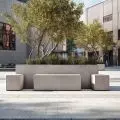The European Parliament elections are just around the corner, and among the most pressing issues facing future MEPs and MEPs are climate issues. What should be addressed first?
As part of our #ReportThursday series, we present documents, reports and guides on architecture, cities and local government that are certainly worth publicizing and promoting. This week we look at the "Manifesto for Sustainable Construction," published through the efforts of the World Green Building Council and its network of partner organizations, including PLGBC.
The material contains a comprehensive set of necessary steps for sustainable architecture, the implementation of which can be undertaken at the EU level. The timing of the manifesto's publication is not coincidental, as the upcoming Sunday, June 9, will be the Europarliamentary elections. For this reason, we believe that the WGBC manifesto is a document with which not only those involved in politics professionally, but each and every one of us should become familiar, since the shape of future European Union policy will depend on our choices in the coming days.
© PLGBC
sustainable development in eight pieces
As defined, the idea of sustainable development is based on three pillars: social, environmental and economic. These pillars are reflected in the eight architecture-related sections identified by those responsible for the manifesto in question. In a certain generalization, the social pillar seems to correspond to the sections on resilience, water management and health aspects of architecture. The environmental pillar is represented by categories discussing actions on greenhouse gas emissions, biodiversity conservation and the circular economy, while economic issues are mainly contained in the spheres of finance and equitable transformation. However, it should not be forgotten that the different categories inter mingle - so, for example, actions in the field of finance must also take into account environmental and social aspects.
Sustainable development goals
© PLGBC
necessary steps
It is important to emphasize that we can talk about sustainable development when the goals related to all the above-mentioned pillars are realized - for this reason, the authors and authors of the manifesto have assigned to each of the eight mentioned sections sets of steps that decision-makers in the European Union should take in order to make the dream of truly sustainable architecture a reality. They have been grouped into three categories: regulations needed - touching on legal aspects; actions - outlining concrete steps in the field of sustainable construction; and incentives - signaling problems and potential ways to solve them. Thus, for example, on the issue of water management, a necessary regulation turns out to be the inclusion in the Energy Performance of Buildings Directive (EPBD) of issues related to monitoring water consumption throughout the life cycle of a building. An action needed for the circular economy is the development of a standardized system of product passports, providing information on characteristics such as the lifespan of products or potential reuse scenarios. On matters related to the financial aspect of sustainable development, the authors and authors of the manifesto in question encourage the development of green in nature insurance mechanisms to promote the construction of buildings with low-carbon properties.
Photo: Danist Soh © Unsplash
wide horizon
A careful reading of the manifesto makes one realize just how holistic and multidirectional is the range of actions needed to achieve the goals of sustainable architecture within the European Union. Promoting sustainable construction must be a priority for the Union, and delivering on declarations to strive for climate neutrality should be one of the basic criteria against which those working in EU structures are held accountable. There is a lot of work to be done - this is clearly evidenced by statistics, as within the community buildings emit as much as 36% of greenhouse gases and generate 40% of total energy demand. At the same time, time is running out, climate change is progressing, and stopping it is in our common interest. We therefore encourage you to take a closer look at this extremely important document, which can serve as a signpost for future politicians working in EU structures, and help those taking part in the upcoming elections to the European Parliament to make the right, most "green" choice possible.
Read the "Manifesto for Sustainable Construction"



























